With rising demand for smart, sustainable infrastructure, modular floating products like pontoons, walkways, and docks are transforming how businesses, governments, and institutions approach water-based construction. From tourism to ports and urban development, their demand is surging internationally.And for Indian manufacturers, this is a golden opportunity.
In this blog, I’ll share:
Who's Purchasing and Why?
Tourism & Leisure: Resorts and waterparks in the UAE, Maldives, Thailand, and the Caribbean are investing in floating lounges and docks.
Maritime Ports & Defence: Countries with coasts are employing floating walkways to dock, for military purposes, and as emergency corridors.
Urban Waterfront Development: European and Asian smart cities are incorporating floating parks, bridges, and cafes.
Why This Market is Growing-
Advantages of Modular Floating Products
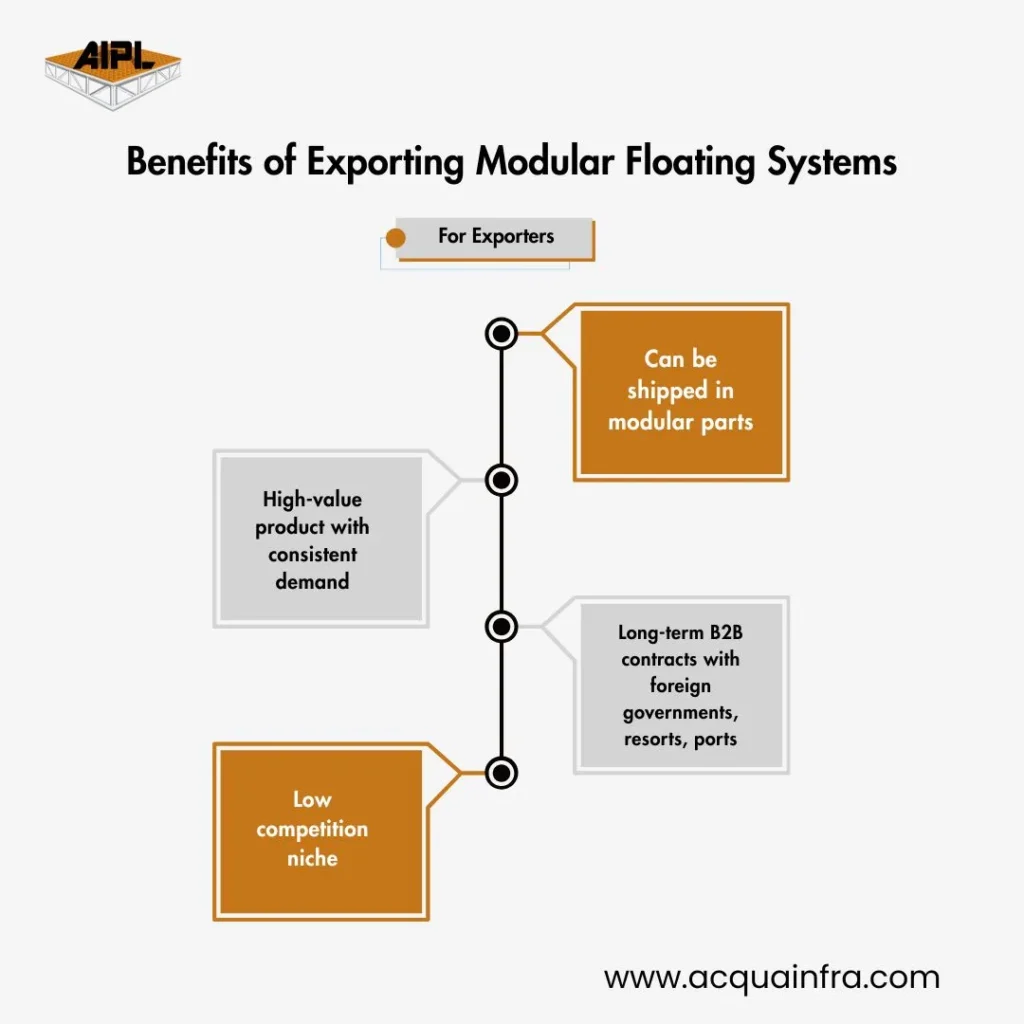
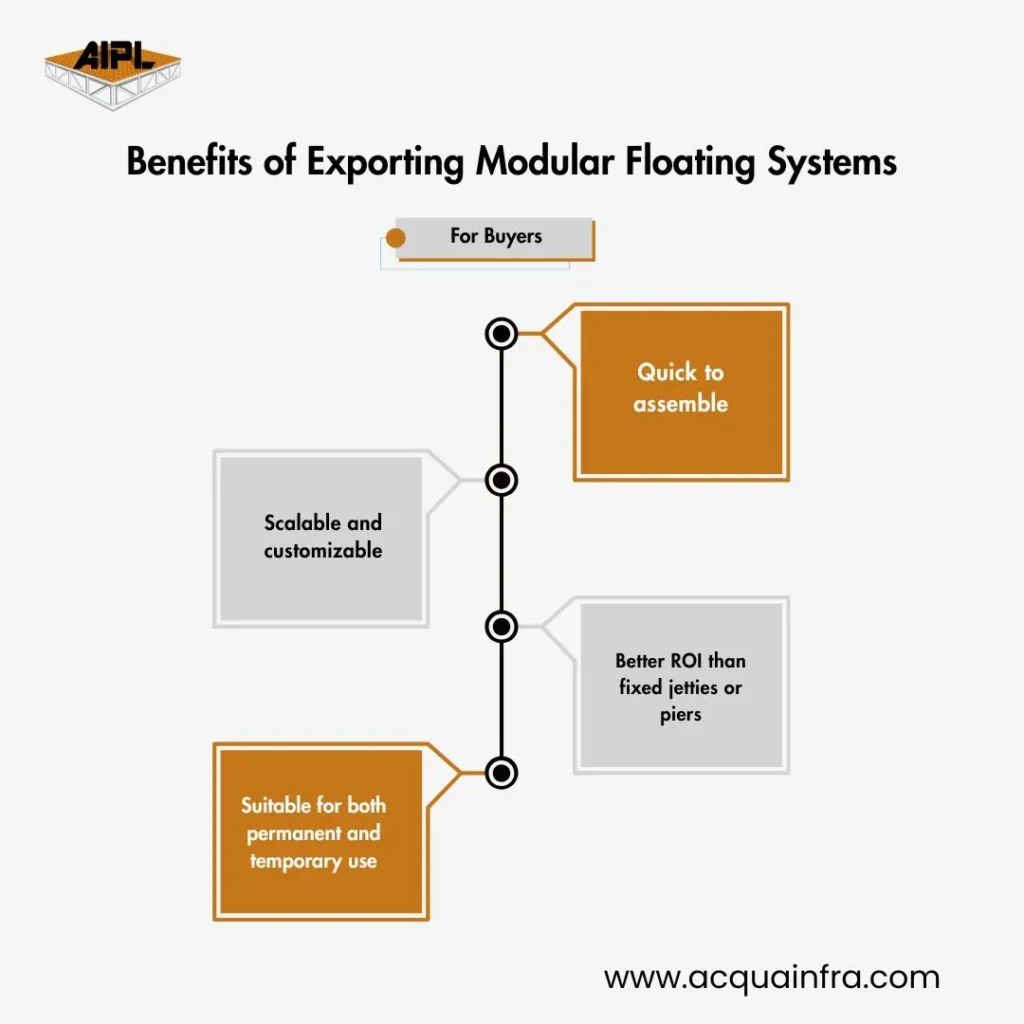
Real Insight:
We have observed East African resorts opt for Indian floating docks based on quality and competitive pricing, opening a clear trade channel.
Benefits of Modular Floating Products
At Acqua Infra Projects (AIPL), we don't only produce — we engineer, design, and export customized floating infrastructure worldwide.
Our team guarantees:
How AIPL Can Help You
With AIPL, it's not an export — it's a global partnership.
Southeast Asian, African, European, and Middle Eastern nations actively import for tourism, ports, and infrastructure development.
Yes. AIPL floats are ISO compliance international standards products, customizable and modularly shipped.
15-30 days according to the port of destination and the documents.
Definitely. Remote and on-site support, even training local team members, are offered by us.
India to the World – Floating with Innovation
Exporting modular floating products isn’t just a business move — it’s an opportunity to build global infrastructure that is sustainable, smart, and efficient. With quality engineering and strategic export support, Indian companies like AIPL are turning waves into pathways.
Let’s connect — if you’re ready to take your floating products global?
With the rising city population and the increasing environmental challenges, effective sanitation is now more essential than ever. Traditional wastewater treatment systems require large infrastructure and a lot of terrain, which is an issue in areas with high populations or regions prone to flooding. Floating platforms provide an environmentally sustainable and sustainable option for issues related to the treatment of sewage, while also protecting the water resources.
These systems are floating units made to treat and clean wastewater directly on the water bodies. These platforms use advanced techniques for filtration and biological treatment, as well as alternative power sources to ensure sustainable and efficient treatment of wastewater.
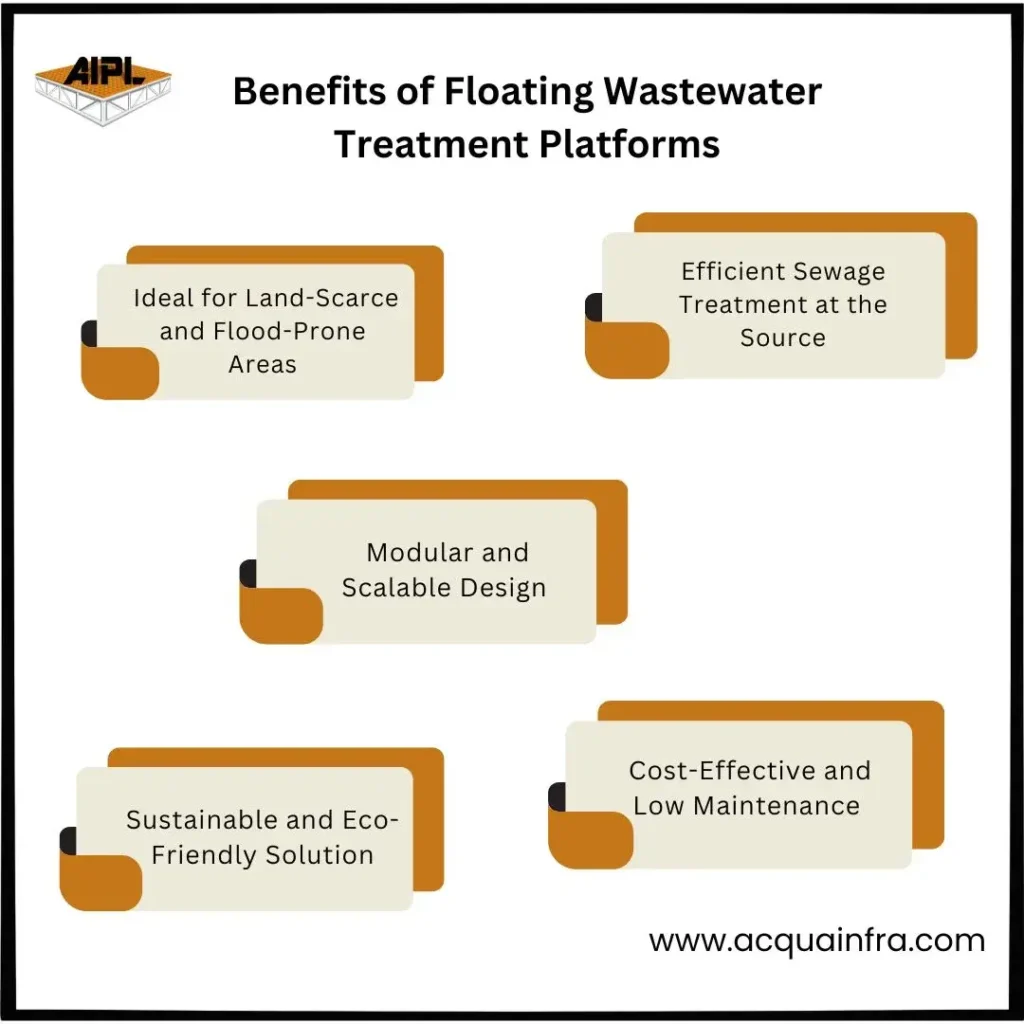
Key Benefits of Floating Wastewater Treatment Platforms
1. Ideal for Land-Scarce and Flood-Prone Areas
Traditional treatment services need huge spaces, while floating platforms work on water bodies, which is why they are ideal for coastal and urban areas.
2. Efficient Sewage Treatment at the Source
Floating platforms are typically situated near lakes, rivers or release areas to keep untreated wastewater from contaminating lakes, rivers and waterbodies in various ways.
3. Modular and Scalable Design
The platform can be modified and expanded to meet the growing needs in wastewater treatment. It can be utilised in small towns as well as larger cities.
4. Sustainable and Eco-Friendly Solution
A large portion of floating treatment units are made up of solar panels and high-efficiency filters that reduce their carbon footprint. They also assist in the rehabilitation of ecosystems within the water by getting rid of the garbage prior to getting into the natural sources.
5. Cost-Effective and Low Maintenance
When compared to the traditional treatment of wastewater, floating platforms require less infrastructure investment and aren't vulnerable to frequent maintenance, which makes them an economically viable option for flood-prone or developing areas.
Primary Treatment removes large particles from waste. Bio-treatment utilises microorganisms and bacteria to remove the organic matter that gets disposed of. Advanced Filtration Membranes are used as chemical processes for purifying water. Disease the water treated is ecologically safe prior to being released to be reused or released.
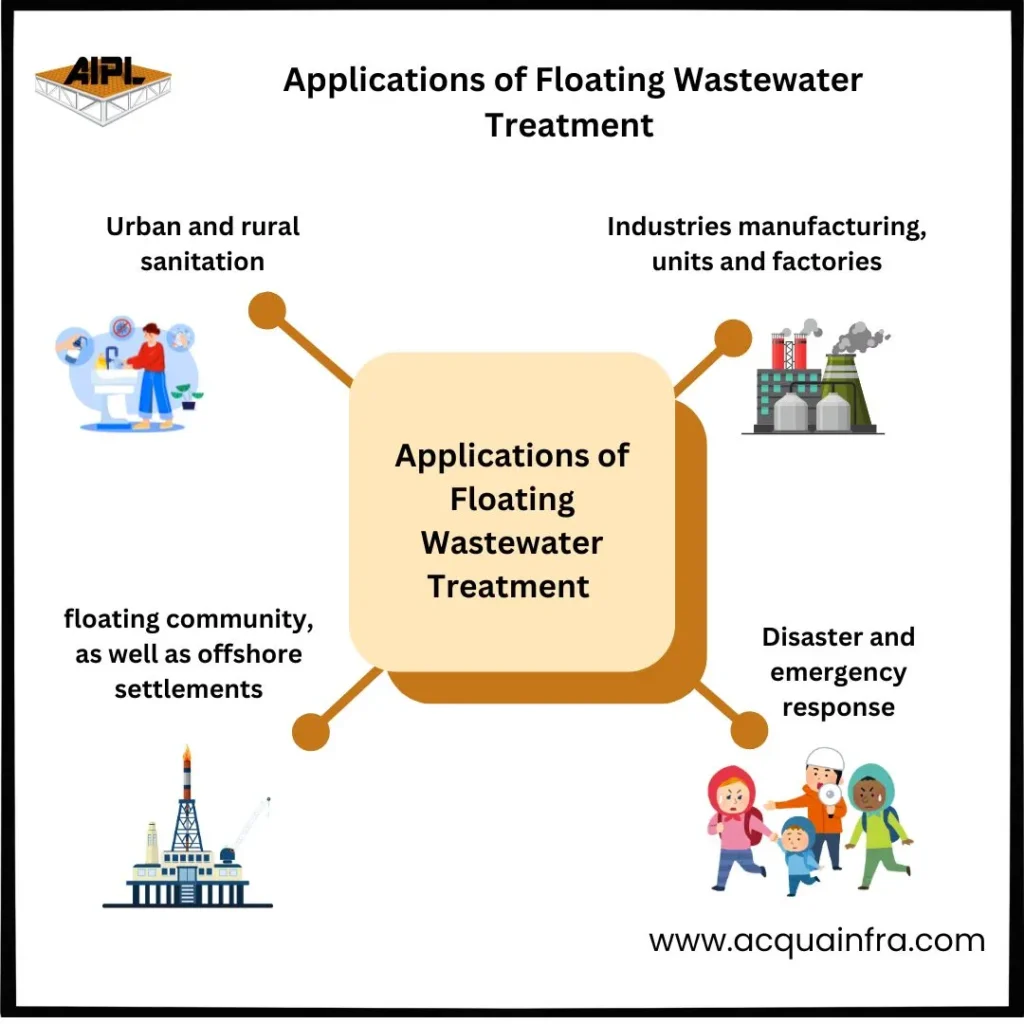
Key Applications of Floating Wastewater Treatment Platforms
Urban and rural sanitation.
Industries manufacturing, units and factories.
floating community, as well as offshore settlements.
Disaster and emergency response.
Managing wastewater efficiently is crucial for urban sustainability. Acqua Infra Pvt. Ltd. (AIPL) provides innovative floating platform solutions designed to enhance wastewater treatment and sewage management. These modular, cost-effective, and eco-friendly platforms ensure efficient water purification while utilizing minimal land space.
They employ a combination of chemical, biological and filtration techniques to get rid of the waste and help protect our environment.
Solar power filtering is a method of use that has minimal impact and eco-friendly methods of treatment to reduce the environmental impact.
They are great for cities with coastlines, towns susceptible to floods, areas of industrial development or communities with a tiny amount of land for water treatment infrastructure.
Indirectly treating water They protect against contamination and increase the quality of water.
Yes, they're adjustable and flexible, which permits the personalisation of levels of pollution in water as well as the treatment needs
Conclusion
Treatment facilities for water that float are a revolution in the landscape of management for water and offer a solid, durable, versatile, flexible, and affordable solution to industrial and urban water issues.
Are you seeking to learn about new strategies for managing water? Visit Acqua Infra today!
At Acquafront Infrastructure Pvt. Ltd. (AIPL), we are experts in cutting-edge floating products with key applications in various industries. A prime example is the application of floating pontoons in the mining industry, specifically for dewatering.
Water management is one of the most important challenges of mining. Floating pontoons provide a sensible, cost-effective, and flexible platform to facilitate this process.
Floating pontoons are portable HDPE or Mild Steel floating Pontoons on water. They can bear pumps, pipes, control units, and even people. Constructed to endure heavy loads and harsh conditions, these pontoons are made to be flexible, long-lasting, and safe.
Conventional dewatering processes usually entail the construction of land-based pump stations, which is time-consuming and expensive. Floating pontoons offer a cost-saving, mobile, and rapid-installation option.
1. Pump Installation on Water
Floating pontoons provide platforms to position all the pumps (Eg: Horizontal Split Case pumps, Submerged Pumps, submersible or vertical pumps) directly over water bodies, enabling pumps to take water directly from pits, reservoirs, or submerged mining areas.
2. Mobility and Flexibility
Pontoons may be moved as water levels fluctuate, providing pump consistency without constructing new platforms or moving pipelines.
3. Stability and Safety
Engineered to be balanced and weight-distributed, pontoons provide for the equipment to operate safely, even in challenging terrains.
4. UV, Chemical, and Corrosion Resistance
AIPL Mild steel pontoons weather out, remain resistant to chemicals, and resist harsh mining environments.
5. Lower Operation Shutdown Time
Instalment with speed and ease of movement leaves less disturbance to mining activity amid heavy rainfall or seasonal floods.
Open Cast Mines: Pontoons mount the pumps which continually drain water and rainwater, or ground-accumulated water.
Sand and Gravel Pits: Floating pump systems ensure best working levels for excavations.
Flooded Quarries: When monsoons occur, pontoons facilitate easy drainage of water without stopping work.
AIPL provides:
Mild Steel Pontoons or Steel Integrated Floating Jetty (SIFJ) pontoons designed to meet site requirements.
Anti-slip load-carrying designs for smooth pump working.
Anchoring and mooring systems to provide stability in mining ponds or pits.
Export-ready pontoons for national or international mining customers.
Turnkey assistance from planning through on-site deployment.
With decades of experience and innovative product design, AIPL is a trusted partner for mining operations looking for effective dewatering solutions.
At AIPL, we don't sell pontoons – we provide tailor-made, site-specific, floating solutions to mining problems:
Our experience with mining and infrastructure clients in India and overseas helps us create practical, long-lasting, and economical solutions.
They accommodate dewatering pumps and machinery, assisting in draining water from mines, ponds, or inundated areas efficiently.
They are portable, simpler to install, and adjust to changing water levels—compared to conventional fixed platforms.
Yes, AIPL pontoons are engineered to support industrial-grade pumps and equipment securely on water surfaces.
Our experts evaluate your location and provide ready-to-install modular pontoons along with anchoring and pump support systems.
Yes, AIPL supplies export-ready floating platforms to international mining and industrial customers.
Effective dewatering is an essential component of any mining operation. With AIPL's floating pontoons, which are modular in design, mining operators have a smart, scalable, and sustainable way to control water and preserve productivity. If you need a proven dewatering system that can be tailored to your mining operation's specific requirements, AIPL stands ready to provide it.
At AIPL, we understand the unique challenges faced by the mining industry. Our custom floating pontoon systems are designed not just to meet those needs, but to exceed expectations. Whether you're tackling dewatering in remote excavation zones or need a durable floating platform for industrial pumps, we’ve got you covered.
Ready to transform your mining operations with efficient, reliable, and cost-effective dewatering solutions?
Contact our team today for a free consultation or a personalised solution for your site.
Flooding is one of the worst natural disasters which can cause huge destruction to infrastructure, homes and even livelihoods. Pumping stations that sit in water are becoming efficient and flexible technology which can help reduce the risk of flooding by effectively managing flood-prone zones' water levels.

A floating pumping station is a small water system specially designed and constructed to transfer excess water from areas of flood to safer locations. Contrary to traditional pumping stations that are built on land, these stations are floating on water bodies, which permits the system to operate effectively in the most extreme flooding conditions.
Pumps of the past are usually destroyed when flood waters submerge pumps that are located on land. Pumping stations that are floating are operational regardless of the rising levels and offer constant water drainage.
These are lightweight to carry and can be installed quickly in areas that are prone to flooding, making them an excellent choice in flooding-related emergency situations.
Floating pumps have the ability to naturally adjust to fluctuating levels of water and also stop blockages and inefficiencies that can impact fixed pumps.
Since they don't require a huge infrastructure on land, floating pumps are able to prove effective in regards to costs and minimize impact on permanently installed flood protection systems.
Alongside providing flood relief floating pumps, these stations will also help keep the level of water in reservoirs, lakes and urban drainage systems which aids in sustainable water management.
Floods can cause severe damage to infrastructure, agriculture, and communities. Traditional drainage systems often fail under extreme water pressure, making floating pumping stations a crucial solution. These stations help manage excess water efficiently, minimizing damage and improving disaster response.
Custom Floating Pump Solutions – Designed for various flood scenarios, ensuring quick and efficient water removal.
Advanced Technology – Equipped with high-capacity pumps, automated controls, and real-time monitoring for better flood mitigation.
Durable & Cost-Effective – Built with corrosion-resistant materials for long-term use with minimal maintenance.
Rapid Deployment – Easily transportable and quick to set up in flood-prone areas.
Eco-Friendly Approach – Ensures minimal environmental impact while managing water effectively.
AIPL’s expertise in floating infrastructure and water management solutions ensures reliable flood control mechanisms that protect lives and property.
Floating pumps draw excess water into designated areas to avoid flooding and to maintain a healthy amount of water.
They can operate on electricity, diesel or alternative sources of energy like solar power based on the location and infrastructure.
They are more mobile, flexible and effective even in case of massive flooding, in contrast to conventional systems built on land, which can be damaged when submerged.
Indeed, through successfully riding stagnant floodwaters, they prevent the spread of malaria-related diseases..
As floods become more frequent and intense, floating pumping stations provide the most effective and practical solution to deal with flooding. By investing in this technology, you'll be able to be sure of rapid drainage of water, less damage and enhanced disaster preparedness.
Are you looking to know more about the latest technologies to manage water? Visit Acqua Infra today!
In this age of global trade, efficient storage and solutions for handling cargo are vital for ports. Due to the rising amount of traffic flowing through traditional warehouses, floating warehouses are growing in popularity as a novel option. A floating warehouse, situated on waterways, is able to increase space, reduce logistics costs and increase the efficiency of handling cargo.
This blog will focus on the concept of benefits, advantages and the introduction of floating warehouses to help support ports. We will also look at how AIPL (Acquafront Infrastructure Pvt. Ltd.) can assist in the creation of floating storage systems that are modular which are efficient and high-performance.
A floating warehouse is a storage facility that is built on floating platforms situated near shipping routes, ports, or along the waters that are inland. They are designed to hold vessels, perishable products as well as bulk items, and guarantee an efficient distribution of cargo, without putting strain on infrastructure on the land.
Why Do We Need Floating Warehouses?

An actual example: Certain European as well as Asian ports are currently examining floating warehouses as a way to better manage cargo and enhance the port's operations.
These built with solid modular platforms that could be used for support of large storage units.
The main characteristics are:
Acqua Infra Pvt. Ltd. (AIPL) is focused on the development and delivery of floating products that are modular including floating warehouses, modular barges, and docking platforms.
Modular Custom-Built Systems Custom-Built according to requirements of your port. Durable and weatherproof materials that guarantee long-term performance. Rapid deployment - Fast assembly, which decreases time to. eco-friendly designs Integrating renewable energy and solar solutions. Assistance from concept through installation.
The main characteristics are:
It's similar to a bustling port where cargo is swiftly transported to floating warehouses, instead of waiting for the terminal space. This speeds up global commerce and decreases delays!

Floating warehouses provide extra storage space near ports, helping reduce congestion and improve the effectiveness of managing the cargo.
The is constructed with solid platforms, strong anchoring mechanisms and weatherproof materials to ensure they're safe and durable.
They enable faster transshipment, lower costs for demurrage, and lower costs for storage and make transporting cargo much more effective.
Yes! Many floating warehouses integrate cold storage solutions for food, pharmaceuticals, and other temperature-sensitive cargo.
AIPL provides custom modular solutions that encompass design, fabrication and the installation of storage systems that are floating.
AIPL offers custom modular floating warehouses designed for efficient port logistics. Contact us today to explore innovative solutions!
The water bodies had always been a barrier to connectivity, leading to the encroachment accessibility to distant regions and the price of transportation has increased. However, floating bridges and walkways have transformed how we travel by water.
If it's a floating bridge that is able to be utilized by vehicles and also as a walking route for pedestrians.
These structures are innovative and offer safe, affordable and long-lasting solutions for urban and rural infrastructure.
In this blog, we'll look at the different ways that floating bridges and walkways work, their benefits and drawbacks, and the methods by which AIPL (Acqua Infra Projects Ltd.) can help create these multi-functional floating structures.

A floating bridge is one constructed on the surface of buoyant water with the pontoon-style floating structures. In contrast to conventional bridges that need foundation pillars, deep floating bridges are constructed on floating platforms which are fixed and therefore suitable for deep water or in difficult terrains.
Connectivity for Urban and Rural Connectivity Urban and Rural Connectivity Connecting rivers and islands in remote areas. Disaster Evacuations and Relief - Quickly-installed structures in floods. Defense & Defense - Temporary bridges that support military operations. Tourist and leisure - Helping access resorts, water parks and nature trails.
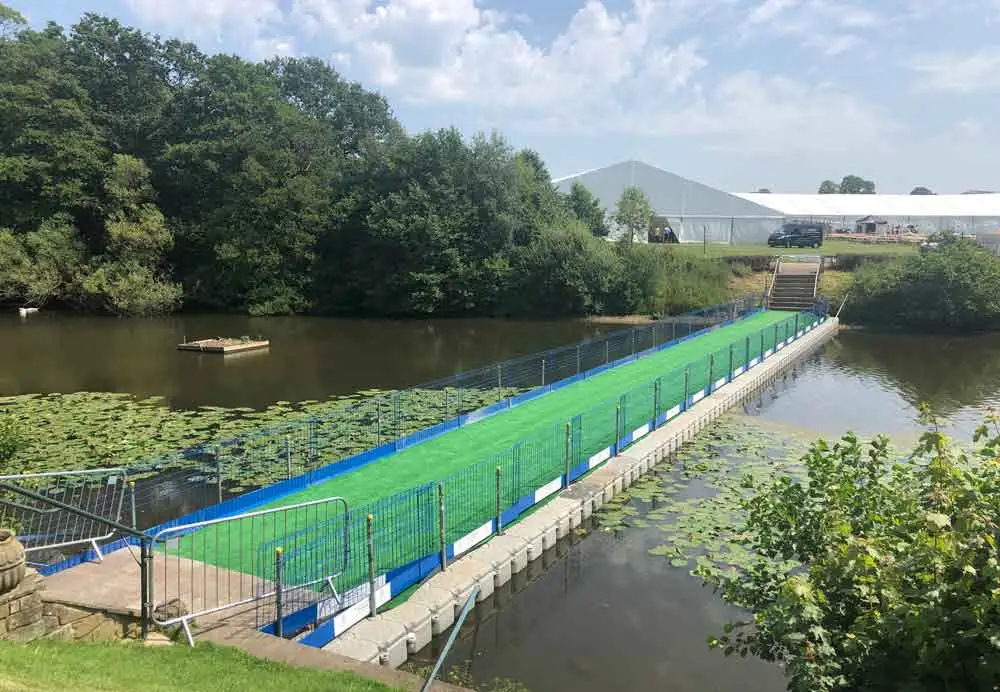
It is an edifice of floating walk that is pedestrian-friendly, built on the water which is supported with floating platforms constructed from modular structures. These structures offer the most secure and safe way to travel through lakes, rivers as well as coastal zones.

Eco-tourism along with Nature Trails - Walking trails that cross wetlands, lakes and mangroves.
These are Recreational Parks and Resorts with floating decks to enjoy leisure activities and boating.
For commercial and industrial applications, access to offshore industry and ports. Temporary events and water Festivals The trails are used that host events and gatherings during the season.
AIPL is an expert of creative floating systems that are flexible making them the ideal partner in the creation of the finest floating walkways and bridges.
Why Choose AIPL?
Modular Systems Custom Built custom-designed to meet the requirements of a variety of environments and applications.
Higher Stability, as well as Safety Standards designed to offer weatherproof features and massive capacity for carrying loads.
Green construction It is built using environmentally sustainable material that is sustainable and renewable.
Easy installation and ongoing maintenance HTML0 platform provides seamless maintenance and installation. All support is provided from creation to installation.
With AIPL's knowledge, floating infrastructure isn't just a figment of imagination today, it's a fact that enhances accessibility and mobility across the world.
With the growing number of cities as well as climate change, floating bridges and walkways are expected to play a major role in ensuring sustainable transportation.
Smart floating bridges that are based on IoT monitors of floating pathways that are powered by solar energy. Hybrid structures that combine smart lighting with green energy.
Imagine taking a stroll along a stunning floating path and being surrounded by nature or driving on an underwater bridge linking two towns that aren't connected. Imagine a world in which two communities are joined. That's the type of future we're creating now!
They employ buoyant pontoons and anchoring systems and advanced design to ensure stability even in turbulent waters.
It's true! They're designed with waterproofing materials, huge capacity for load and an anti-slip flooring to provide the best security.
Absolutely! Modern designs contain waves, winds, as well as resistance to loading making them incredibly durable.
They are constructed from HDPE steel reinforced concrete, bio-friendly composites to provide strength and durability.
AIPL provides the complete modular floating solution that offers customizable, reliable and high-quality designs that can be adjusted to the various circumstances.
Looking for innovative floating infrastructure? Connect with AIPL to build custom floating bridges and walkways for urban and industrial applications.
Contact AIPL today and transform water mobility!
Mr. Ankit Patel, Director & CEO.
Industrial expertise in Business Development, Operations, Finance & Administration, and Product development.
Navkriti Medal issued by Indian Institute of Technology (BHU), Varanasi.
National Meritorious Innovation Award 2018 by NRDC (A DST Enterprise) presented during Innovate India conference 2019 at EDII, Ahmedabad.
Recognised for groundbreaking innovation with patent no. 485553 in the Marine Industry
As cities grow and as transport needs change, innovative infrastructure solutions are becoming more important. The floating Helipad has revolutionised the industry. The floating helipads allow helicopters to take off and land on the water. They are an excellent alternative for landing in areas where space is limited. These helipads are also great for offshore operations and emergency services.
The floating helipad has become a reality with modular floating technology. This is a solution to urban and maritime transport.
A floating helipad is a specially designed platform that floats on water. The helipad is used for landing and taking off helicopters. It's constructed from lightweight materials that are strong and durable, such as mild steel, steel-reinforced HDPE cubes, concrete or reinforced composites.
Floating helipads are commonly found in coastal cities, islands and offshore industries. They can also be seen on luxury yachts, emergency services or marine hospitals.
Land for aviation infrastructure is expensive and difficult to acquire in many cities.
Floating helipads can be used in zones prone to disaster for rapid medical evacuation when there is flooding, hurricanes, or maritime accidents.
For industries like offshore construction, oil and gas and offshore construction, it can be ideal. Workers, scientists and equipment can be transported easily.
They provide VIP transportation to luxury yachts, island resorts and other destinations. Exclusive travel experiences are offered.
The helipads can be used for coastal defense, rescue missions, and strategic surveillance.
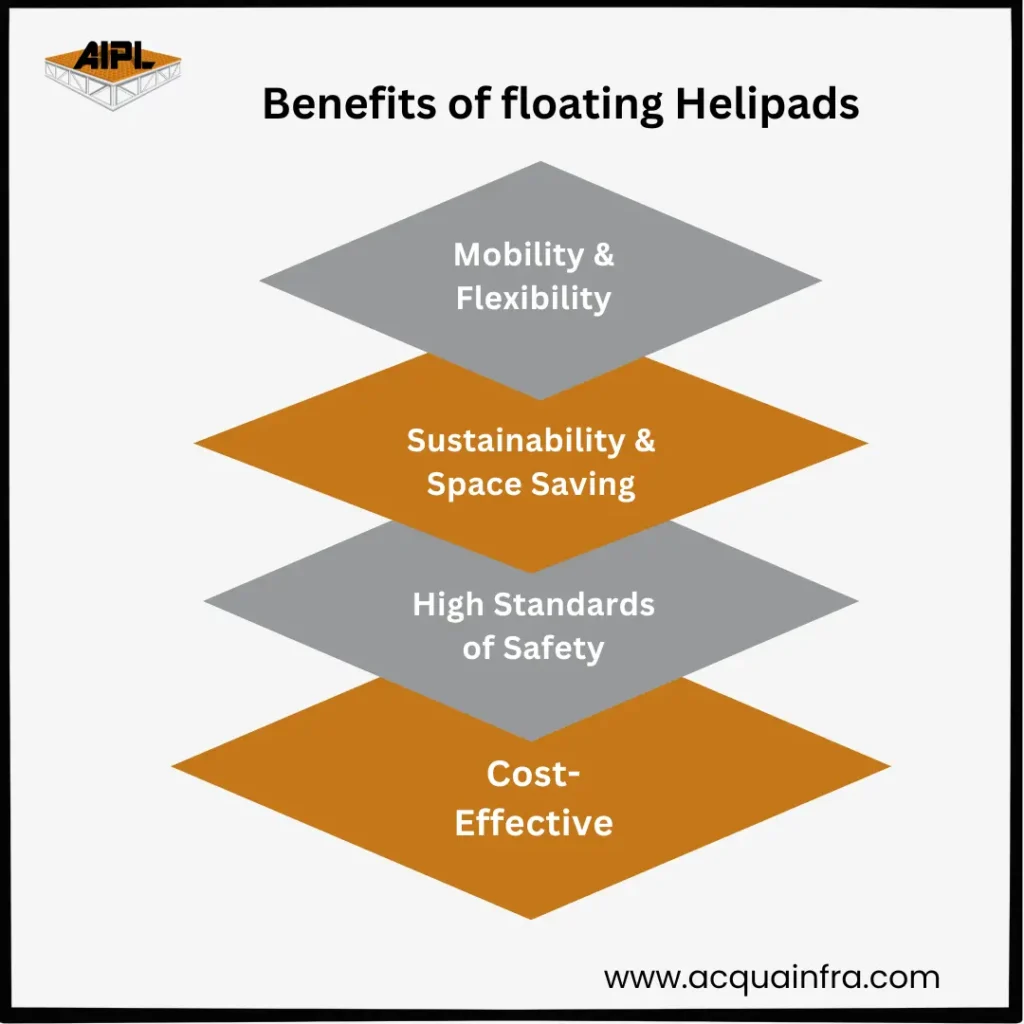
Mobility & Flexibility- Helipads can be repositioned easily to meet the needs of users, whether temporary or permanent.
Sustainability & Space Saving- They utilize surface water without damaging the natural ecosystem or taking valuable land space.
High Standards of Safety- Engineered with stabilisation technology, floating Helipads ensure safe landings in diverse water conditions.
Cost-Effective – Unlike traditional heliports that require large infrastructure investments for construction and maintenance, built and maintained with a lower price tag.
Customizable and Scalable Modular design allows extension to meet operational needs.
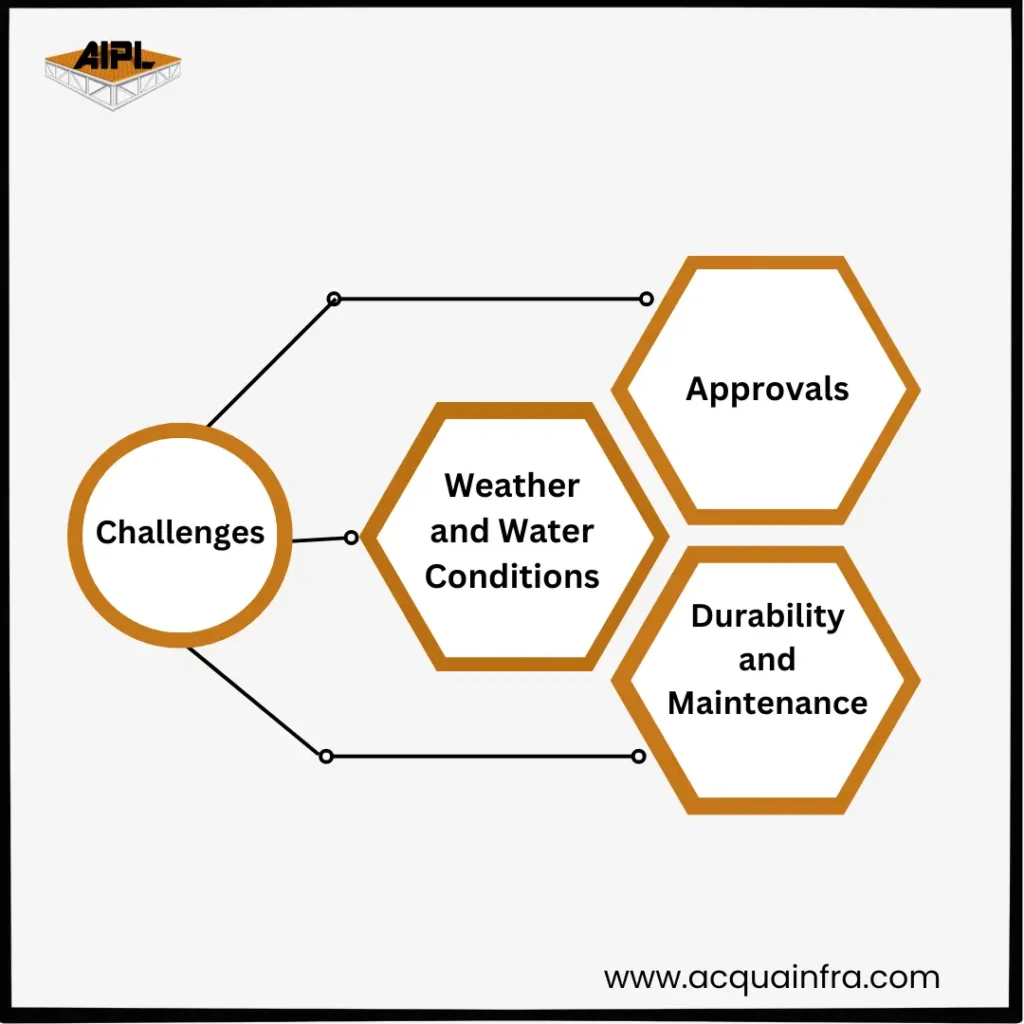
While floating helipads offer many advantages, they also present some challenges.
Weather and Water Conditions - Extreme weather conditions and high waves may impact operations, and require advanced stabilization mechanisms.
Approvals - Complying with Aviation & maritime regulations can be complex and take a long time.
Durability and Maintenance - Regular inspections and maintenance are important for maintaining functionality and safety.
Acqua Infra projects Ltd., a company specializing in floating modules, is the ideal partner for delivering cutting-edge floating helicopter pad.
Modular & scalable design – AIPL’s helipads can be expanded or relocated as needed.
High-Stability Platforms - Built using advanced maritime engineering for safe landings, takeoffs and landings.
Custom Built Solutions Designed to meet the specific needs of industrial or emergency applications.
Uses Sustainable Materials to minimise environmental impact.
AIPL provides support for design, deployment, and maintenance.
AIPL’s floating Helipad Solutions is ideal for Governments and Private Sectors that are looking to create a safe and innovative air transportation infrastructure.
With the advancement of electric aviation, drones and smart infrastructure , it is expected that floating helipads will play a major role in urban air mobility and emergency response.
Future developments may include: AI-Powered navigation & safety systems integration with eVTOL (Electric vertical takeoff and landing Aircraft) Solar powered floating helipads for green energy solutions
As the population grows and mobility requirements increase, solutions like floating helipads are needed to bridge land, air and sea transportation.
Imagine the future, where helicopters will land on water, providing luxury travel, medical assistance and urban air mobility. It's not a dream, it is happening right now!
A floating helipad provides a stable surface for helicopters to land and take off from water. This is a common transport option for luxury and emergencies.
The boats have stabilization systems to ensure safety under different conditions of water.
Yes! These platforms are modular and mobile, allowing them to be moved or expanded based on operational needs.
The floating helipads do meet maritime and aviation standards. The floating helipads ensure safe landings, take- offs and take-offs.
AIPL offers modular float platforms that are of high-quality and customized, designed to ensure stability, safety, and durability when helipad operations.
Do you want to revolutionize air mobility and emergency response? Find out how AIPL’s floating modular helicopter pads will transform transportation.
Contact us now for more information about our custom-built floating helipads that will redefine the future of aviation! AcquaInfra
As the world shifts towards sustainable solutions, the idea of floating CNG stations is currently being created as a major move in the field of infrastructure to fuel. One of the most stunning installations is currently happening in the historical Khirkiya Ghat in Varanasi which is where the very first floating CNG filling station was set up. The station has now been a model for technological innovation and environmental sustainability.
A Breakthrough at Khirkiya Ghat The central part of this amazing design is 324 square. millimeter. floating structure built through GAIL India Limited, designed to cater to the needs of cruise ships powered by CNG as well as vessels operating in the Ganga River. This unique design actively tackles critical environmental issues, including air and noise pollution, as well as river contamination, while ensuring year-round functionality, even during floods.
Floating CNG (Compressed Natural Gas) stations are innovative fueling solutions designed to provide CNG supply to water-based transportation systems, such as boats and ferries, without the need for land-based infrastructure. These stations are strategically placed on floating platforms, allowing seamless refueling in waterways while addressing environmental concerns.
A Floating CNG Station consists of:
Floating CNG stations offer multiple advantages for the marine industry. They are eco-friendly, significantly reducing water, air, and noise pollution compared to traditional diesel-powered boats. These stations provide efficient fueling, eliminating the need for vessels to travel long distances for refueling, thereby saving time and operational costs. Additionally, they are cost-effective, allowing boat operators to benefit from lower fuel expenses. Designed to adapt to varying water levels, floating CNG stations ensure year-round operation, functioning seamlessly even during floods or seasonal water changes.
CNG-based stations that float have several benefits: Sustainability for the Environment In assisting vessels powered by CNG, they dramatically minimize noise and air pollution and help create cleaner and more sustainable waterways. Performance: Designed to run without a hitch, even during the flooding season.
They provide continuous service for fueling. Space Optimization Since they're floating over the waters, these stations effectively utilize space, and they also bypass limitations on land areas with high density of waterfronts. Advanced Technology at Play This new venture is because of the use in the form of Modular floating Mild Steel Barges.
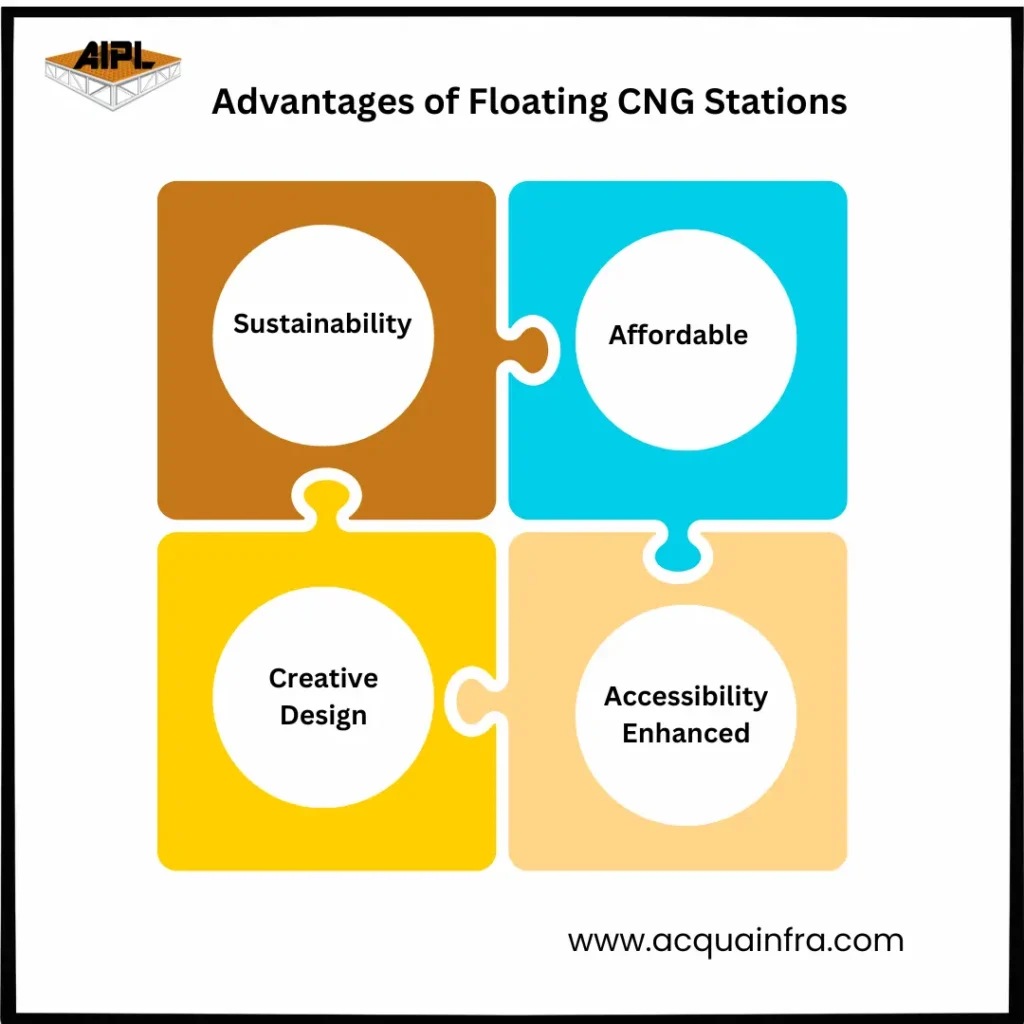
The floating Tank used to complete the filling of CNG situated within Khirkiya Ghat is not just about the latest technological advances, it's an important step towards preserving the earth. Reduction of water pollution Through reducing the magnitude of impact caused by spills of oil and fuel. Reduction of Noise It's more quiet than diesel engines that are more traditional and create a peaceful atmosphere. More clean air CNG is an environmentally friendly fuel option that reduces the harmful emissions. The CNG Station floating located in Khirkiya Ghat is a testament of India's commitment to sustainable energy solutions. It will transform the fuel infrastructure of all waterways around the world.
As the demand for sustainable energy solutions grows, floating CNG stations offer an innovative way to provide compressed natural gas (CNG) in remote and water-based areas.
At AIPL (Acquafront Infrastructure Pvt Ltd), we specialize in the design, manufacturing, deployment, and installation of modern floating infrastructure. Our advanced floating platforms are engineered to support CNG dispensers, making energy distribution more efficient, accessible, and reliable.
With our expertise in modular floating technology, we ensure cost-effective, durable, and safe solutions that meet industry standards while maximizing operational convenience.
Proven Expertise: AIPL built the world's first floating CNG filling station at Khirkiya Ghat, Varanasi, and GAIL India Limited successfully launched it into service.This historic project demonstrated AIPL's capacity to offer creative and long-lasting solutions.
AIPL designs and engineers Modular Floating Mild Steel Barges, ensuring scalability, stability, and long-lasting performance.This ensures that operations are safe and effective all year long, especially during flood seasons.
Tailored Solutions: AIPL provides customized solutions to satisfy particular needs, guaranteeing optimal operational effectiveness and environmental sustainability, from conception to installation.
Principal Advantages of Working with AIPL
Sustainability of the Environment: By promoting CNG-powered boats and excursions, AIPL's Floating CNG Stations contribute to a reduction in air, water, and noise pollution.
Space Optimization and Flexibility: AIPL guarantees effective space use while preserving the ability to grow or move as necessary by leveraging floating platforms.
AIPL provides comprehensive solutions, such as:
Planning and Consultation: Comprehending customer requirements and creating tailored plans for the installation of floating CNG stations.
Design and Engineering: Making use of cutting-edge modular designs to provide maximum safety and functionality.
Installation and Commissioning: Providing professional technical assistance to guarantee a smooth and effective installation procedure.
Maintenance and Support: To ensure continuing service, provide ongoing maintenance and operational support.
AIPL is transforming the future of fuel infrastructure with a strong dedication to technological innovation and environmental sustainability.
The Future of Floating CNG Stations
They are sustainable and provide creative solutions to urban issues and encourage eco-friendly use of CNG fuel. Countries that are embracing renewable energy initiatives could be the first to adopt this revolutionary approach.

A CNG station is an area to store fuel on a platform. It is a place to store natural gas that is compressed and utilized in boats and vehicles.
They're created with the latest technologies and security standards in order to guarantee safety and stability in the storage of fuel.
Floating CNG stations address the problem of a shortage of land. They encourage the use of green fuels and offer assistance to those living located in remote areas or who are bound by water. They offer a cost-effective, efficient solution.
The promotion of use in the utilization of CNG as a sustainable energy source. CNG stations help reduce carbon emissions and assist in the reduction of polluting.
Join forces with AIPL to provide your waterways with cutting-edge, environmentally friendly fuel infrastructure solutions.
Find out how floating CNG stations are setting the foundation in the direction of sustainable travel. To find out more about this cutting-edge technology and its effect on the protection of the environment, visit Acquafront Infrastructure. Ltd. today!
About the Author
Mr. Achin Agrawal, Director & CTO.
Imagine dining in a stunning restaurant that floats gently on an idyllic water body providing stunning views of the sunset, sky as well as city lights. Floating restaurants are a booming trend in the world, blending cuisine, ambience and natural beauty to create memorable experiences. If it's a romantic meal or family gathering or a corporate gathering they offer more than food. They provide memories.
Floating restaurant: A place to eat constructed on water, as an unmoving house or vessel. These incredible places are located on barges, boats, and floating platforms that are built on rivers, lakes, bays, or even oceans.

1. Ambience
It's calming and luxurious to enjoy the experience of dining with the water at your feet. Whether it's breakfast in the morning or dinner at sunset the atmosphere is unbeatable.
2. Tourist Attractions
Restaurants on boats are increasingly becoming a major attraction for food and travel lovers as they provide something new to experience.
3. Ideal for Celebrations
It doesn't matter if it's a birthday or wedding celebration, these floating venues add excitement to events due to their scenic elegance and luxury.
4. Fresh & Local Cuisine
Many floating restaurants are specialized in local and fresh fish as well as regional delights, eating out not just pleasant but authentic.
5. Sustainability
In the current emphasis on green practices, Some floating restaurants utilize solar power as well as rainwater harvesting and waste management methods.
Jumbo Floating Restaurant (Hong Kong): A famous seafood paradise with traditional Chinese architecture, located on the water.
The Rock Restaurant (Zanzibar, Tanzania): A small floating restaurant surrounded by the Indian Ocean, offering stunning ocean views.
Bateaux Parisiens (Paris, France): A floating dining cruise along the River Seine with views of iconic landmarks like the Eiffel Tower.
Sea Palace (Amsterdam, Netherlands): A beautiful floating Chinese restaurant resembling a traditional pagoda.
Kerala Houseboats (India): Unique floating restaurants on the backwaters, combining Indian cuisine with natural landscapes.

Maintenance Costs: Because of natural factors like water erosion and weather conditions the floating restaurants require regular maintenance.
Security: Guests need to be able to guarantee their safety in extreme weather conditions or on the water.
Space is limited: managing seatings and kitchens on floating structures requires the right planning.
The compliance to Maritime, Environmental and Safety Laws
They are erected on sturdy barges, floating platforms designed specifically to be in the water to guarantee safety and stability.
Yes, it's constructed with strong anchoring systems as well as the right safety precautions to ensure that it can withstand all weather conditions.
Floating restaurants usually specialize in fresh seafood, local dishes and local food however they also offer international cuisine.
Certain are docked at an anchor point, whereas others serve like dining boats on lakes and rivers.
Yes, prices vary depending on the location, service and the food. But there are many floating restaurants that offer cheap eating.
Acquafront Infrastructure Pvt. Ltd. (AIPL) specializes in designing and delivering modular floating solutions, making it the perfect partner for bringing your floating restaurant vision to life. Whether you're looking to create a luxurious fine-dining experience on the water or an eco-friendly café with a stunning waterfront view, AIPL ensures seamless execution with cutting-edge technology and expertise.
✅ Customizable Modular Design
AIPL provides fully customizable floating platforms that cater to your restaurant's size, theme, and seating capacity. Whether you need a compact floating café or a multi-level fine-dining experience, our modular floating barges are engineered for stability and durability.
✅ Eco-Friendly & Sustainable Solutions
We prioritize environmental sustainability by using low-impact, corrosion-resistant materials and energy-efficient features. Our solutions help reduce water pollution and support sustainable tourism.
✅ Weather-Resistant & Safe Structures
AIPL's floating restaurants are designed to withstand fluctuating water levels, strong currents, and adverse weather conditions, ensuring year-round operation with minimal maintenance.
✅ Turnkey Project Execution
From design conceptualization to final deployment, AIPL manages every aspect of the project, including:
✅ Smart Infrastructure & Technology Integration
AIPL offers smart infrastructure solutions, including solar-powered lighting, energy-efficient appliances, and waste management systems, ensuring smooth restaurant operations with minimal environmental impact.
✅ Expert Consultation & After-Sales Support
Our team provides continuous support to ensure optimal functionality, from maintenance services to future expansions.
With AIPL’s expertise in modular floating infrastructure, you can transform any riverfront, lake, or coastal location into a thriving, high-end dining experience. Whether it’s for tourism, hospitality, or exclusive waterfront events, we make your dream project a floating reality.
AIPL is your trusted partner in delivering world-class floating restaurants with precision and efficiency. 🌊🚢 From logistics to installation, we ensure a seamless process so you can focus on creating unforgettable dining experiences.
Let’s bring your floating restaurant vision to life! ✨ Contact us today to discuss how we can support your project. 📩📞 #FloatingRestaurants #AIPL #SeamlessDelivery
Floating restaurants are more than just food, they offer a unique experience. No matter if you're a gourmand or nature-loving traveling, dining out on water is an experience you'll be remembering. As these eateries gain popularity all over the world, they rethink quality, sustainability, and the way we experience food and the natural world.
Mr. Ankit Patel, Director & CEO.
Industrial expertise in Business Development, Operations, Finance & Administration, and Product development.
Navkriti Medal issued by Indian Institute of Technology (BHU), Varanasi.
National Meritorious Innovation Award 2018 by NRDC (A DST Enterprise) presented during Innovate India conference 2019 at EDII, Ahmedabad.
Recognised for groundbreaking innovation with patent no. 485553 in the Marine Industry
Floating dredgers play an essential function in a variety of sectors like building and environmental management. These dredgers are frequently utilized in rivers, mines and ports, and can ensure the effective removal of sediments as well as keeping waterways. Being fascinated by the advancement of technology and the power it has to transform I've explored the details of dredgers in to give you this in-depth guide. Let's take a peek at the main reasons why dredgers can be floating and how they benefit our infrastructure and the environment.
A floating dredger can be described as a device that can be used to extract contaminants from water bodies such as lakes, rivers, or oceans. The machines are anchored to floating platforms or barges which allow the utilization of any water-based habitat.Scope Clearing of sediments the navigational route, as well as mining the water resource.The principle of operation is fitted with cutting system, pipelines pumps, for instance. They remove materials and then move them to the appropriate location.

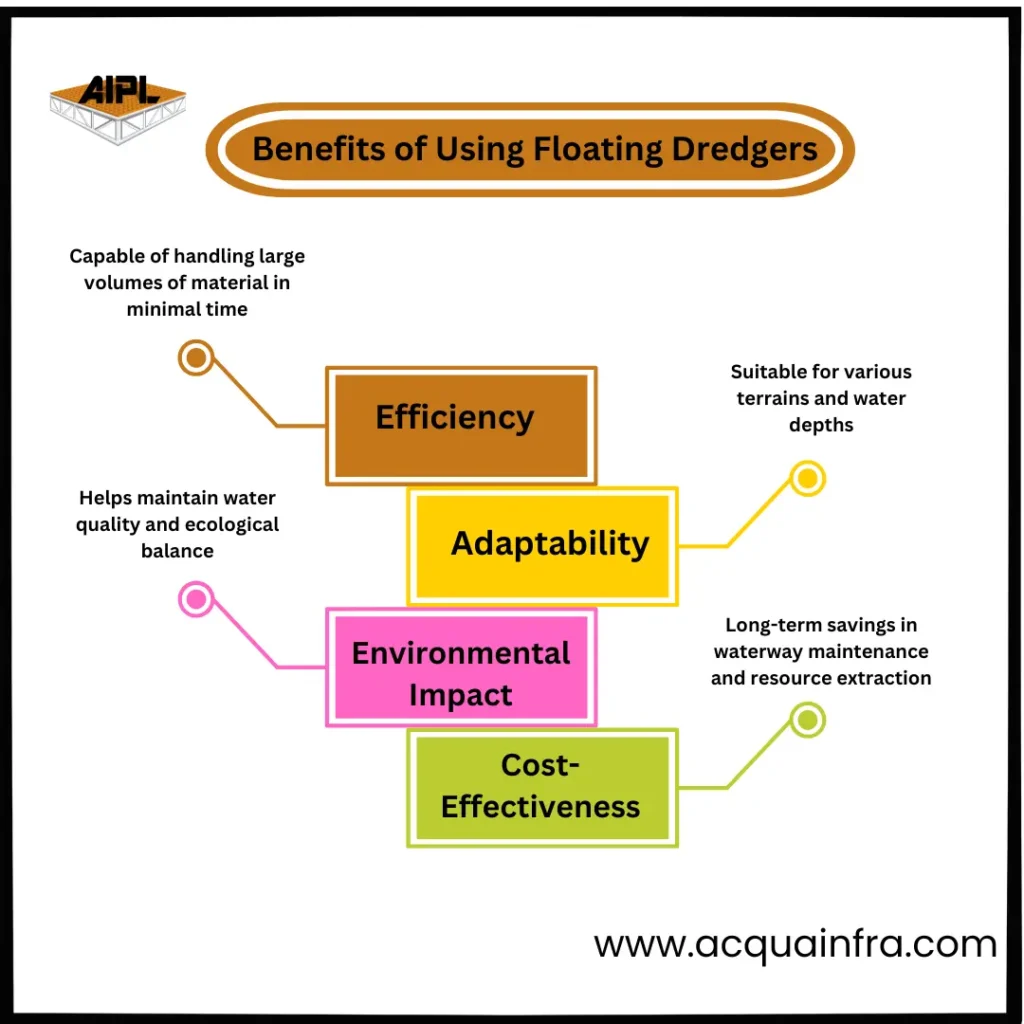
Acquafront Infrastructure Pvt. Ltd. (AIPL) offers Modular Barges, which are container-sized units made of mild steel that are built to handle large loads. They are inspected by IRS, IIT, CIPET and NABL which guarantees high-quality and reliability. Their modular design makes it easy for transportation and apprehension on many waters, making the barges ideal for a range of purposes.
By using AIPL's Modular barges, customers can benefit from an effective and flexible solution which is customized to their particular needs for their project. For transport, construction or any other marine-related activities, barges can be a highly efficient system that can be tailored to meet particular requirements.
Floating dredgers may be used in mining, construction or maintenance work on rivers, as in eco-restoration projects.
They aid in cleaning polluted water bodies, restore ecosystems, and prevent flooding by regulating levels of sediment.
If it is taken care of correctly, the lifespan of a dredger will range from 20 to 30 years.
When maintained properly and using modern technology floating dredgers may reduce their impact on the environment.
Take note of factors like what depth the water is and the type of material employed in addition to the overall size of the project as well as budget before choosing the ideal Dredger.
AIPL can help make the transfer to your dredgers floating seamless effortless, easy, and effective. With our industry-leading expertise and dedication to quality we will ensure that your equipment gets to its delivery promptly and is in good condition.
Let's join forces to bring your ideas to the next stage. Contact AIPL today to find out the ways our customized solutions can help you achieve your goals. Call us now or go to our website for more information!
Mr. Ankit Patel, Director & CEO.
Industrial expertise in Business Development, Operations, Finance & Administration, and Product development.
Navkriti Medal issued by Indian Institute of Technology (BHU), Varanasi.
National Meritorious Innovation Award 2018 by NRDC (A DST Enterprise) presented during Innovate India conference 2019 at EDII, Ahmedabad.
Recognised for groundbreaking innovation with patent no. 485553 in the Marine Industry
